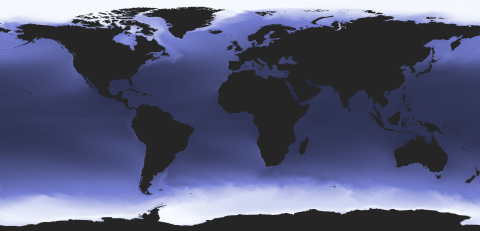New release of the Bio-Oracle dataset v3
Bio-Oracle provides environmental data of the world ocean for present and future climate change scenarios. These data are mainly used by Lifewatch users to link biodiversity occurrence data to environmental conditions and predict the future distribution of marine species. The new version offers increased spatial and temporal resolution.

The Bio-Oracle consortium proudly announces the release of version 3 of the Bio-Oracle dataset, offering significant enhancements and additions to its environmental data repository. Bio-Oracle, an essential resource for modeling the distribution of marine biodiversity under various climate change scenarios, continues its commitment to providing high-quality data for researchers worldwide.
This new version features a comprehensive range of marine data layers covering physical, chemical, biological, and topographic aspects. These layers have global coverage and are presented on a uniform grid system with a spatial resolution of 0.05 degrees. The data spans from 2000 to 2100, with a temporal resolution of 10 decadal steps. The variables are provided in six different statistics for both surface and benthic conditions, under present-day circumstances and six distinct climate change scenarios based on the Shared Socioeconomic Pathways outlined in the IPCC Sixth Assessment Report.
All layers are stored in NetCDF format and are accessible through an ERDDAP server for easy filtering and downloading in various data formats. Additionally, specialized Python (pyo_oracle) and R (biooracler) packages have been developed to streamline data retrieval and enhance integration with existing bioclimatic modeling frameworks.
Explore the new version at bio-oracle.org or read the new paper released in Global Ecology and Biogeography (click here to access the paper in the Open Marine Archive)
Bio-Oracle is supported by VLIZ as part of the by the Flemish contribution to Lifewatch (https://www.lifewatch.be/), together with UGent (Phycology research group) and other international organizations part of the Bio-Oracle consortium.
This new version features a comprehensive range of marine data layers covering physical, chemical, biological, and topographic aspects. These layers have global coverage and are presented on a uniform grid system with a spatial resolution of 0.05 degrees. The data spans from 2000 to 2100, with a temporal resolution of 10 decadal steps. The variables are provided in six different statistics for both surface and benthic conditions, under present-day circumstances and six distinct climate change scenarios based on the Shared Socioeconomic Pathways outlined in the IPCC Sixth Assessment Report.
All layers are stored in NetCDF format and are accessible through an ERDDAP server for easy filtering and downloading in various data formats. Additionally, specialized Python (pyo_oracle) and R (biooracler) packages have been developed to streamline data retrieval and enhance integration with existing bioclimatic modeling frameworks.
Explore the new version at bio-oracle.org or read the new paper released in Global Ecology and Biogeography (click here to access the paper in the Open Marine Archive)
Bio-Oracle is supported by VLIZ as part of the by the Flemish contribution to Lifewatch (https://www.lifewatch.be/), together with UGent (Phycology research group) and other international organizations part of the Bio-Oracle consortium.



